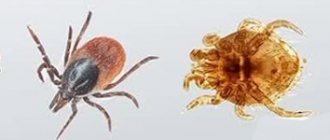Smallpox
Smallpox (black smallpox) is a particularly dangerous, highly contagious infectious disease of viral origin.
It is characterized by airborne transmission, two-wave fever, severe intoxication, and the staged appearance of a thick vesicular-pustular rash on the skin and mucous membranes, after the resolution of which characteristic deep scars (pockmarks) remain. Mentions of smallpox were found in the most ancient written medical sources of Egypt, India, China, it was described in detail by such outstanding doctors of antiquity as Hippocrates and Galen, but the first reliable study is considered to be the work of the Arab scientist Rhazes “On Smallpox and Measles,” created in the 9th century. X centuries AD e. He considered measles to be a type of smallpox. The difference between these two diseases was established by the famous Avicenna.
The smallpox virus is highly contagious, so the incidence often took the form of epidemics. Every third of those who fell ill died, and according to rough estimates, from the 5th to the 20th centuries, smallpox claimed from 400 to 600 million lives. A breakthrough in the fight against the disease was the discovery of the smallpox vaccine by the English physician Edward Jenner in 1796. He discovered that milkmaids who had direct contact with cows with cowpox did not become ill during human smallpox epidemics. To confirm his theory, he publicly rubbed the purulent contents of a smallpox pustule into an 8-year-old boy, inoculating him with cowpox in this way, and a month and a half later he attempted to infect him with smallpox, but the boy remained healthy - this is how not only a safe vaccine against smallpox was discovered, but and the vaccination method itself (the name comes from the Latin word vacca - cow).
Smallpox is considered an infection that has been eradicated worldwide. On May 8, 1979, 155 member countries of the World Health Organization (WHO) endorsed the findings of the Global Commission and certified the eradication of the disease, namely:
- Smallpox eradication has been completed worldwide.
- There is no data on the possibility of smallpox re-emerging as an epidemic disease.
Later, in February 1979, the Global Commission recommended maintaining smallpox virus cultures in several laboratories for scientific purposes. Currently it is stored in two laboratories - in the USA and in Russia.
Diagnostics
The smallpox virus is the causative agent of an infectious disease with a characteristic clinical picture. All the symptoms of the disease are so specific that diagnosis does not cause any particular difficulties for specialists. The diagnosis is made based on the patient’s appearance and taking into account the epidemiological situation in the patient’s region of residence.
- The hemogram reveals an increase in the number of leukocytes and a sharp shift in the formula to the left.
- Molecular biological methods can quickly and accurately detect smallpox virus. Polymerase chain reaction, immunofluorescence and enzyme immunoassays, counter-diffusion and gel precipitation reactions give a preliminary result that requires confirmation in a classical way.
- Virological research - isolation and identification of the infectious agent. The biomaterial for analysis is the contents of smallpox vesicles, pustules, crusts, a swab from the throat and nose. A diagnosis of smallpox can only be made by employees of the laboratory of especially dangerous infections, who are subject to special, extremely stringent requirements for performing diagnostic tests.
- Specific antibodies can be detected in the blood of patients. To do this, serological reactions are performed: neutralization, complement fixation, hemagglutination inhibition.
Causes
The main causative agent of smallpox is Variola major, a DNA virus of the Poxviridae family, characterized by its large size (210–260 nm). The Variola major virus is responsible for the most severe and most virulent form of smallpox. The disease can also be caused by the Variola minor (Alastrim) virus, in which case it, although it has all the signs of smallpox, is less severe and less likely to lead to death (in 1% of cases versus 30% mortality of Variola major). When talking about smallpox, we usually mean its severe form, since the variant of the disease caused by Variola minor was recorded only in West Africa and, in isolated cases, in America.
In skin cells and mucous membranes, the virus forms clusters called Guarnieri bodies. The smallpox virus is resistant to temperature fluctuations, retains its vital activity for a long time at low temperatures, and lives for about two years at room temperature. It tolerates drying well, in this form it is resistant to adverse factors, for example, it can withstand 10-minute boiling. Resistant to antibiotics, inactivated within 1 hour with a 3% chloramine solution.
Human susceptibility to smallpox ranges from 85–100%.
The source of human infection can only be a sick person or a virus culture introduced from outside. A person is a source of infection from the very beginning of the disease until the crusts that form after the abscesses dry out completely fall off. Presumably, the patient is contagious already during the incubation period, before the first signs of the disease appear, and with the onset of the rash he becomes highly contagious.
Smallpox rashes are areas where the virus multiplies and is released as soon as the vesicles and pustules break out. Therefore, the more rashes, the more dangerous the patient is to others. The contents of smallpox elements are mixed with the saliva and sputum of patients and spread during coughing and sneezing. It can also serve as a source of infection, remaining on the linen and other things of patients.
The most significant way of spreading the virus is through airborne droplets, since the virus can spread through the air over long distances, far beyond the premises where the patient is located. Since the virus is resistant to desiccation, the infection can also be transmitted by airborne dust, that is, carried with dust. You can also become infected through damaged skin or things; through direct contact, the virus can be carried by insects, including flies.
source
Sasha Ospenny and Anton Vaktsinov
In Russia at that time, every seventh child died from smallpox. Smallpox vaccination in Russia began in 1768 with the variolation of the royal family - Catherine II and her son Paul. The empress was subsequently called a true hero, and historians compared her act with the victory over the Turks. The smallpox material was taken by the invited British doctor G. Dimedal from Sasha Markov, a seven-year-old peasant boy. The doctor received the title of baron from the royal family, and Sasha received the surname Ospenny and the nobility.
Jenner's student, Professor E. O. Mukhin, in 1801 made the first vaccine in Russia, obtained from its inventor. In the presence of royalty, Anton Petrov, a pupil of a Moscow noble house, was vaccinated with smallpox pathogens. The procedure was successful, and the boy received the surname Vaccinov and a lifelong pension. A corresponding decree was issued, and by 1804 smallpox vaccination was carried out in 19 Russian provinces, almost 65 thousand people were vaccinated.
Biology report on the topic: “Human viral diseases”
Completed by: Daria Vdovkina, 7th grade student
Checked by: Olga Vladimirovna Vdovkina,
teacher of biology and ecology
Viruses are the smallest causative agents of numerous infectious diseases in humans and animals. They are intracellular parasites, incapable of life outside living cells. Diseases that are caused by viruses are easily transmitted from sick people to healthy people and spread quickly. Much evidence has accumulated that viruses are the cause of various chronic diseases. These are smallpox, polio, rabies, viral hepatitis, influenza, AIDS, etc. Many viruses to which humans are sensitive infect animals and vice versa. In addition, some animals are carriers of human viruses without getting sick.
Pathogen: Myxovirus of one of three types - A, B and C - with varying degrees of virulence. Influenza is an acute infectious disease of the respiratory tract caused by the influenza virus. Included in the group of acute respiratory viral infections (ARVI). Periodically spreads in the form of epidemics and pandemics. Currently, more than 2000 variants of the influenza virus have been identified, differing in their antigenic spectrum. All age categories of people are susceptible to influenza. The source of infection is a sick person with an obvious or erased form of the disease, who releases the virus by coughing, sneezing, etc. The patient is contagious from the first hours of the disease until the 3-5th day of the disease. It is characterized by an aerosol (inhalation of tiny droplets of saliva, mucus that contain the influenza virus) transmission mechanism and extremely rapid spread in the form of epidemics and pandemics. Influenza epidemics caused by serotype A occur approximately every 2-3 years, and those caused by serotype B occur every 4-6 years. Serotype C does not cause epidemics, only isolated outbreaks in children and weakened people. It occurs more often in the form of epidemics in the autumn-winter period. The frequency of epidemics is associated with frequent changes in the antigenic structure of the virus when it remains in natural conditions. High-risk groups are children, the elderly, pregnant women, people with chronic heart and lung diseases. Type of vaccination: the strain of the killed virus must match the strain of the virus causing the disease
Smallpox
Smallpox, or, as it was previously called, smallpox, is a highly contagious (infectious) viral infection that affects only humans.
Pathogen: variola virus (DNA virus), one of the smallpox viruses. Mortality rate is 20-40%, according to some data - up to 90%. People who survive smallpox may lose some or all of their vision, and almost always have numerous scars on the skin where the former ulcers were. Smallpox has been known to mankind since ancient times. The variola virus has an antigenic affinity with red blood cells of group A in human blood, which causes weak immunity, high morbidity and mortality in the corresponding group of people. It is resistant to environmental influences, especially drying and low temperatures. It can be preserved for a long time, for a number of months, in crusts and scales taken from pockmarks on the skin of patients; in a frozen and lyophilized state it remains viable for several years. Smallpox is an anthroponotic disease and is a highly contagious, especially dangerous infection. All people are susceptible to smallpox unless they have immunity acquired through previous illness or vaccination. Smallpox was widespread in Asia and Africa. It is an airborne infection, but inoculation of the virus is possible through direct contact with the affected skin of the patient or objects infected with it. The infectiousness of the patient is observed throughout the entire disease - from the last days of incubation to the rejection of the crusts. The corpses of those who died from smallpox also remain highly infectious. When contaminated air is inhaled, viruses enter the respiratory tract. Infection through the skin during variolation and transplacentally is possible. The virus enters the nearest lymph nodes and then into the blood, which leads to viremia. The epithelium is hematogenously infected, where the virus multiplies, which is associated with the appearance of enanthema and exanthema. Weakening of the immune system leads to the activation of secondary flora and the transformation of vesicles into pustules. Due to the death of the germinal layer of the epidermis, deep suppurative and destructive processes, scars are formed. Infectious-toxic shock may develop. Severe forms are characterized by the development of hemorrhagic syndrome. Type of vaccination: A live, weakened virus is applied to a scratch on the skin; not currently applied. The last case of the disease was reported in Somalia in October 1977; The virus is extinct in nature. Currently, the smallpox virus exists only in two laboratories in the United States and Russia. The question of the final destruction of the smallpox virus has been postponed until 2014. Measles
Measles is an acute infectious viral disease with a high level of susceptibility (the contagiousness index approaches 100%), which is characterized by high fever (up to 40.5 ° C), inflammation of the mucous membranes of the oral cavity and upper respiratory tract, conjunctivitis and a characteristic maculopapular rash of the skin, general intoxication.
The causative agent of measles is an RNA virus of the genus Morbilliviruses, family of Paramyxoviruses. It has a spherical shape and a diameter of 120–230 nm. It consists of a nucleocapsid - an RNA helix plus three proteins and an outer shell formed by matrix proteins (surface glucoproteins) of two types - one of them is hemagglutinin, the other is a “dumbbell-shaped” protein. The virus is not stable in the external environment and quickly dies outside the human body from exposure to various chemical and physical factors (irradiation, boiling, treatment with disinfectants). Despite its instability to the external environment, there are known cases of the virus spreading over significant distances with air flow through the ventilation system - during the cold season in one single building. Weakened strains of measles virus are used for the production of live measles vaccine. The route of transmission of infection is airborne; the virus is released into the external environment in large quantities by a sick person with mucus during coughing, sneezing, etc. The source of infection is a patient with measles in any form, who contagious to others from the last days of the incubation period (last 2 days) until the 4th day of the rash. From the 5th day of the rash, the patient is considered non-infectious. Measles affects mainly children aged 2-5 years and much less often adults who did not have this disease in childhood. Newborn children have colossal immunity, passed on to them from their mothers if they have had measles before. This immunity lasts for the first 3 months of life. There are cases of congenital measles due to transplacental infection of the fetus with the virus from a sick mother. After an illness, stable immunity develops; re-infection with measles in humans, without concomitant pathology of the immune system, is doubtful, although such cases have been described. Most cases of measles are observed in the winter-spring (December-May) period, with an increase in incidence every 2-4 years. Currently, in countries that carry out total vaccination against measles, the disease occurs in the form of isolated cases or mini-epidemics. Type of vaccination: Live attenuated virus Poliomyelitis (infantile paralysis)
Poliomyelitis is infantile spinal paralysis, an acute, highly contagious infectious disease caused by damage to the gray matter of the spinal cord by poliovirus and characterized mainly by pathology of the nervous system.
Basically, it occurs in an asymptomatic or erased form. Sometimes it happens that the poliovirus penetrates the central nervous system, multiplies in motor neurons, which leads to their death, irreversible paresis or paralysis of the muscles they innervate. The entrance gate of infection is the mucous membrane of the nasopharynx or intestines. During the incubation period, the virus multiplies in the lymphoid formations of the pharynx and intestines, then penetrates the blood and reaches nerve cells. The most pronounced morphological changes are found in the nerve cells of the anterior horns of the spinal cord. Nerve cells undergo dystrophic-necrotic changes, disintegrate and die. With less constancy, similar but less pronounced changes are observed in the cells of the brain stem, subcortical nuclei of the cerebellum, and to an even lesser extent - cells in the motor areas of the cerebral cortex and dorsal horns of the spinal cord. Hyperemia and cellular infiltration of the pia mater are often observed. The death of 1/4-1/3 of the nerve cells in the thickenings of the spinal cord leads to the development of paresis. Complete paralysis occurs when at least 1/4 of the cellular composition dies. After the end of acute events, the dead cells are replaced by glial tissue, resulting in scarring. The size of the spinal cord (especially the anterior horns) decreases: with unilateral damage, asymmetry is noted. Atrophy develops in muscles whose innervation has been damaged. Changes in internal organs are minor - in the first week a picture of interstitial myocarditis is noted. The transferred disease leaves behind a persistent, type-specific immunity. AIDS
Acquired immune deficiency syndrome is a condition that develops against the background of HIV infection, characterized by a decrease in the number of CD4+ lymphocytes, multiple opportunistic infections, non-infectious and tumor diseases.
HIV is transmitted through direct contact of mucous membranes or blood with body fluids containing the virus, such as blood, semen, vaginal secretions, or breast milk. HIV infection is not transmitted through saliva and tears, or through household contact. It is believed that the spread of HIV infection has now become pandemic. In 2008, the number of people living with HIV was about 33.4 million, the number of new infections was about 2.7 million, and 2 million people died from AIDS-related illnesses. According to data for 2006-2007, the top ten countries with the largest number of HIV-infected people are: India (6.5 million), South Africa (5.5 million), Ethiopia (4.1 million), Nigeria (3 .6 million), Mozambique (1.8 million), Kenya (1.7 million), Zimbabwe (1.7 million), USA (1.3 million), Russia (1 million) and China (1 million) HIV-infected patients often have increased rates of cancer. This is primarily due to co-infection with oncogenic DNA viruses, especially Epstein-Barr virus ( EBV
), Kaposi's sarcoma-associated herpesvirus (human herpesvirus 8), and human papillomavirus (
HPV
). Kaposi's sarcoma is the most common tumor occurring in HIV-infected patients.
source
Historical excursion
Today, smallpox is the only viral infection that, through the efforts of epidemiologists, has been eradicated on all continents. But it was not always so. The last reliable case of infection with this disease was recorded in 1977, and in 1980 the World Health Organization declared the eradication of this disease. The term "smallpox", or Variola, appears in the records of Bishop Marius of Avencha (570 AD), although, judging by the description of the symptoms, it was smallpox that wiped out a third of the inhabitants of Athens in the 430s BC and was the pestilence that mowed down the soldiers of the army of Marcus Aurelius during the Parthian Wars in 165-180 AD. The Crusades of the 11th-13th centuries ushered in the march of smallpox across Europe and Scandinavia. Spanish conquistadors brought smallpox to South America. There, 90% of the indigenous population died from it. Until recently, smallpox was an epidemiological disease, the mortality rate of which exceeded 40%.
Grateful humanity
The name of Edward Jenner has gone down in the history of humanity's fight against pandemics. In many countries, monuments have been erected to him, universities and laboratories are named after him. He became an honorary member of many scientific societies and academies, and some Indian tribes even sent him honorary belts. In 1853, a monument to him was unveiled in London (at first it was located in Trafalgar Square, later it was moved to Kensington Gardens), at the opening of which Prince Albert said:
Not a single doctor has saved the lives of such a significant number of people as this man.
The great sculptor Monteverdi created another monument that immortalized the moment of smallpox inoculation of a child. The sculpture was installed in Boulogne (France). And if Jenner is deservedly considered the author of the discovery, then the child James is his co-author, although he had no idea what role he would play in the fate of all humanity.
The threat remains
After 1980, most countries abandoned mandatory vaccination of the population. Our contemporaries are already the second generation that lives unvaccinated. However, despite the fact that the pathogen is carried only by humans, there is no guarantee that the primatepox virus does not mutate. The second threat of the disease returning is the lack of guarantees that WHO has complete data on preserved strains of the virus. It’s not for nothing that after the 2001 scandal in the United States, when envelopes containing anthrax spores were sent out, all American military personnel were vaccinated against smallpox. Let's hope that vaccine stocks in epidemiological laboratories will still remain unclaimed.
Preventive measures
Preventive measures come down to vaccination. Unvaccinated people are all susceptible to the pathogen; humans have no natural immunity to this disease. Children under four years of age are especially susceptible. Modern vaccines are grown in chicken embryos or tissue culture. There are several of them in the world, all of them have been certified by WHO. Vaccination is carried out with contaminated bifurcation needles, which make up to 15 punctures on the forearm. After which the vaccination site is closed. Fever and myalgia are possible for a week after the procedure. The success of the operation is verified by the presence of a papule on the 7th day. Immunity lasts 5 years, after which it begins to decline and becomes negligible after 20 years. Today, vaccination is indicated only for people whose professional activities involve a high risk of infection (employees of relevant laboratories).
Source of biological hazard
Data on the use of smallpox as a biological weapon are known. Thus, during the French and Indian War (1756-1763), Great Britain used smallpox as a biological weapon against France and the Indians. There is evidence of research into smallpox-based weapons during World War II (1939-1945). There is a version that the United States considered the scenario of using such weapons during the Vietnam War on the Ho Chi Minh Trail. During the Cold War, the Soviet Union conducted research into combining the smallpox and Ebola viruses. However, these studies were not widespread due to the ineffectiveness of such weapons due to the availability of smallpox vaccines. But even today there are materials appearing in the media that instill certain alarming sentiments.
Pathological changes
Photo of smallpox virus
Skin changes
On the skin of corpses who died from smallpox, there is a rash in varying degrees of maturity. Macroscopically, in the initial period, with the papular nature of the rash, inflammatory phenomena are detected in the papillary and subpapillary layers of the skin and swelling of the epidermis, and then, with the development of a macroscopically visible vesicle, serous exudate leaks into the thickness of the epithelium and the formation of cracks in the epidermis; due to significant inflammatory exudation in them, part of the partitions between them breaks through (the cellular structure of the developed pockmarks). At the edge of the necrotic lesion, a strong proliferation of epithelial cells occurs, surrounding the central necrotic lesion in the form of a roller and leading to the formation of a central depression (smallpox umbilical). Subsequently, suppuration and destruction of the affected area of the skin occurs and then gradual healing with the formation of a scar due to connective tissue proliferation of the destroyed corium or without the formation of a scar in the form of temporary pigmentation (with suppuration of only the epidermis).
Changes in mucous membranes
Rashes are also observed on the mucous membranes of the mouth, pharynx, esophagus, vagina, and colon. When a rash occurs on the mucous membranes, due to the absence of a dense layer of epithelium, the contents of the vesicles quickly break through to the surface with the formation of ulcers. The formation of extensive ulcers and necrosis may be due to the addition of an additional third-party infection.
Changes in parenchymal organs
The spleen appears significantly enlarged due to plethora and hyperplasia of pulp cells. Degenerative phenomena are observed in parenchymal organs (heart, liver, kidneys). Testicular damage presents with a picture of acute necrotizing orchitis with temporary stromal edema and disintegration of the tubular epithelium. In the bone marrow, mainly in the epiphyses, areas of serous-fibrinous impregnation with necrotization of the formed elements are found.
Changes in hemorrhagic form
In hemorrhagic forms of smallpox, hemorrhages are observed in places of specific smallpox changes, as well as in various parts of the body (in the serous cavities, renal pelvis, bladder, uterus, ovaries, mediastinum, muscles, etc.).
Complications
They can occur in 1 vaccinated person per 10 thousand patients. Primarily associated with skin diseases. Contraindications include pregnancy, autoimmune diseases, and eye inflammation. Severe complications include encephalitis (1:300,000), eczema, myocarditis, pericarditis, and rash of non-infectious origin. However, vaccination will prevent or significantly reduce the severity of the disease. It is recommended for all family members of the patient and contact people for whom quarantine is established for at least 17 days.
Symptoms
In the classic version, the onset of the disease is acute: chills, severe malaise, aching muscles and joints, intense pain in the lumbar region, fever up to 40-41°C. Then the temperature drops to subfebrile levels and remains at this level for 3-4 days. At this time, rashes appear on the face, scalp, hands, and the spaces between the fingers and toes. On the second day from the onset of the rash, the rash spreads to the torso, then to the limbs. Initially, the rash looks like small (up to 3 mm in diameter) rounded pink spots, which after 5-6 hours turn into papules.
After 1-2 days, the papules transform into vesicles with cloudy contents. The vesicles are multi-chambered, with a dense bottom, have an oblong shape, and are surrounded by a strip of hyperemia.
Smallpox rashes thickly cover the skin and mucous membranes
After 1-2 days, the contents of the vesicles become purulent, pustules form, the temperature again reaches febrile values, and then high fever accompanies the entire period of the existence of the pustules. The blisters burst, pus flows out of them, causing skin irritation and severe itching. The patient's condition during this period is extremely serious. All systems of the body suffer from intoxication, especially the cardiovascular system; itchy skin causes insomnia. Often trying to get rid of it, patients themselves puncture the purulent blisters, thereby spreading the rash to healthy areas of the skin.
Gradually, the pustules from which pus has leaked become covered with dry brown crusts, which begin to fall off by 3-4 weeks from the onset of the disease, leaving scars in their place.
The blood picture is characterized by leukopenia, lymphocytosis, thrombocytopenia.
On the issue of the need for vaccination
According to epidemiologists and infectious disease specialists, all infections are controllable, and they are controlled by vaccination. By refusing preventive vaccinations, we risk making the infection uncontrollable. This is exactly what happened with diphtheria, when in the 90s, residents of the post-Soviet space massively refused to be vaccinated. The diphtheria epidemic of 1994-1996 clearly demonstrated the inconsistency of such refusals. Doctors from European countries traveled to the CIS countries to see what diphtheria looks like.
Today, smallpox is not the only disease defeated by humanity. In developed countries, the deadly companions of humans—whooping cough, mumps, and rubella—are on the verge of extinction. Until very recently, the polio vaccine contained three serotypes (different types of virus). Today it already contains two serotypes - the third type of pathogen strain has been eliminated. To be vaccinated or not is up to everyone to decide for themselves. But do not underestimate the achievements of medicine and neglect basic methods of protection.











